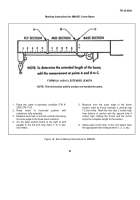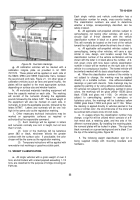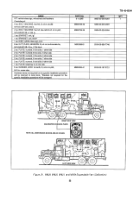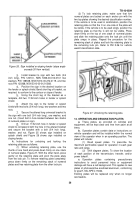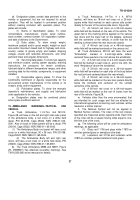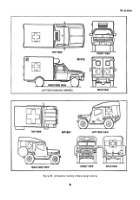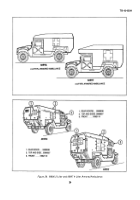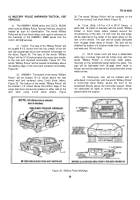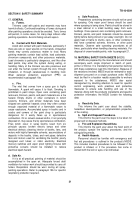TB-43-0209 - Page 36 of 406
TB 43-0209
SECTION V. SAFETY SUMMARY
17. GENERAL
a.
Fumes.
Thinners used with paints and enamels may have
harmful effects. Continued breathing of fumes during and
after painting operations should be avoided. Toxic fumes
will persist, in some cases, for many days indoors after
painting operations. Avoid inhaling solvent vapors.
b.
Contact with Paint Materials
.
Avoid skin contact with paint materials, particularly if
there are cuts or open wounds on the hands. Unwashed
hands may convey poisonous matter to food. Many
painting materials contain lead sulfide, lead carbonate,
chromium compounds, and other poisonous materials.
Lead chromate is particularly dangerous, and like other
lead paints, may enter the system during eating, or
handling. Many of the thinners are also poisonous and
can enter the human system through the skin, through
inhalation, or through carelessness in handling food.
Wear
personal
protection
equipment
(PPE)
as
recommended in paragraph 19a.
c.
Fire
.
The mist that comes from a spray gun is highly
flammable. A spark will cause it to flash. Smoking is
prohibited in paint shops. Open cans containing paint
removers, thinners, paints, and paint materials are a fire
hazard. Empty drums or other containers in which
solvents, thinners, and similar materials have been
shipped are potential hazards since they often contain
enough vaporized material of a flammable nature to
cause explosions. Accumulated spray in booths and in
cracks and comers of the paint shop is particularly
dangerous for it easily flares up in spontaneous
combustion. Oil or solvent-soaked cloths, if not promptly
disposed of, may cause fire by spontaneous combustion.
Fires which occur in spray booths result from six
principle causes: broken electric lamps and other
electrical defects; cleaning interior of booths, fans, and
motors with highly flammable solvents; accumulations of
deposits in the booths, tubes, and vent pipes; defective
fans and motors used for ventilating the booths; poorly
designed vent tubes; or static electricity. Electrical
mercury switches and vapor proof lighting fixtures with
protective screens should be installed to reduce
electrical spark hazard.
d.
Safe Air
.
If it is at all practical, painting of material should be
accomplished in the open air. Adequate forced draft
ventilation for indoor work should be provided to carry off
fumes. Respirators should be worn during all spray-
painting operations. Refer to paragraph 19b for specific
respiratory protection required.
e.
Safe Practices.
Preparations containing benzene should not be used
for spraying. Only vapor proof lamps should be used
where spraying is being done. Paints should be stored in
a steel cabinet in a small building away from work
buildings. Once opened, cans containing paint removers,
thinners, paints, and paint materials should be covered
tightly before being stored or put away overnight. Do not
apply heat or flame to drums, cans, or other containers
that have contained solvents, thinners, or other paint
materials. Observe safe operating procedures at all
times, particularly when handling cleaning materials. For
disposal of unserviceable paints, refer to paragraph 21.
18. MATERIAL SAFETY DATA SHEETS (
MSDS)
MSDS are prepared by the manufacturer and should
accompany each single shipment or batch of paint,
primer or thinner. It is mandatory that personnel working
with these substances read this information. Because of
the variations involved, MSDS must be reviewed for each
shipment procured on a single purchase order. MSDS
must be filed in a location readily accessible to workers
exposed to the substances. MSDS also assist
management by directing attention to need for specific
control engineering, work practices and protective
measures to ensure safe handling and use of the
material. Along with the products ingredients and specific
protection information, the MSDS contain the following
data:
a.
Reactivity Data.
This informs the paint user about the stability,
hazardous decomposition, or polymerization properties
of the coating.
b.
Spill al d Disposal Procedures.
This informs the paint user the steps to be taken for
proper spill or disposal methods.
c.
Fire and Explosion Hazard Data
.
This informs the paint user about the flash point of
the product, special fire fighting procedures, and the
extinguishing media.
d.
Health Hazards.
Personnel should be familiar with emergency and
first aid procedures -s outlined in the product’s MSDS.
This includes medical procedures to be followed if the
product is inhaled, or if the procedure has come in
contact with the skin or eyes of an individual.
31
Back to Top

